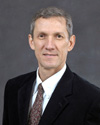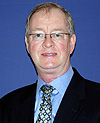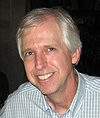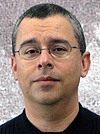
2010 Overset Grid Symposium Invited Speakers
Overflow Applications in Transonic Airplane Design
Tuesday, 8:00 a.m.
Stephen R. Chaney, The Boeing Company

Stephen R. Chaney has worked at Boeing for 29 years in aerodynamic analysis and design of air vehicles. He is a recognized expert in CFD applications for high-speed aerodynamics. In Boeing Commercial Airplanes, Steve has been a leader in the application of Navier-Stokes methods (Overflow) to airplanes for drag prediction, configuration design, and Navier-Stokes-based numerical aerodynamic shape optimization efforts on the 787 Program. Prior to that, Steve developed many of these Overflow application methods while working on the high-speed aerodynamic design of the HSCT and Sonic Cruiser. He received his B.S. and M.S. from the University of California, Berkeley.
Steve is currently a Boeing Associate Technical Fellow in the Commercial Airplanes Product Development group in Everett, Washington.
Application of Overset Grid Methods to Wind Turbine Rotors
Wednesday, 8:00 a.m.
C.P. “Case” van Dam, University of California at Davis

C.P. “Case” van Dam is a professor of mechanical and aerospace engineering at the University of California at Davis and heads the California Wind Energy Collaborative; a partnership between the University of California and the California Energy Commission. Before joining UC Davis in 1985, Case was employed as a National Research Council (NRC) post-doctoral researcher at NASA Langley Research Center and as an engineer at Vigyan Research Associates in Hampton, Virginia. His current research includes wind energy engineering, aerodynamic drag prediction and reduction, high-lift aerodynamics, and active control of aerodynamic loads. Case has extensive experience in computational aerodynamics, wind-tunnel experimentation and flight testing; teaches industry short courses on aircraft aerodynamic performance and wind energy; has consulted for aircraft, wind energy, and sailing yacht manufacturers; and has served on review committees for various government agencies and research organizations; and has been the recipient of numerous honors and awards including the Lawrence Sperry Award of the American Institute of Aeronautics & Astronautics.
20+ Years of Chimera Grid Development for the Space Shuttle
Thursday, 8:00 a.m.
Pieter G. Buning, NASA Langley Research Center

Pieter Buning received BS degrees in Aerospace Engineering and Computer Engineering from the University of Michigan, and MS and PhD degrees in Aeronautics and Astronautics from Stanford University. He joined NASA Ames Research Center in 1979, studying numerical methods, computational efficiency, and scientific visualization, authoring the PLOT3D visualization code for computational fluid dynamics (CFD). Pieter began work on overset grid methods in 1987 with the NASA Ames Space Shuttle Flow Simulation Group, led by Joseph Steger. This work, in collaboration with team members at Ames and Johnson Space Center, led to development of the OVERFLOW CFD code and various grid generation tools for complex configurations.
Pieter transferred to NASA Langley in 1996 where he continues to work on CFD tool development and applications including stage separation; capsule aerodynamics; and Mars entry, descent, and landing. He is currently in the Computational AeroSciences Branch at Langley, where his research is focused on improving the accuracy of CFD simulation of rotorcraft flows.
Reynaldo Gomez, NASA Johnson Space Center

Reynaldo Gomez began working at NASA Johnson Space Center (JSC) in May 1985 after completing a B.S. in Mechanical Engineering from Rice University. He has worked on a wide range of computational fluid dynamics (CFD) applications over the last 20 years, ranging from simulations of wind loads on the Shuttle prior to launch through hypersonic reentry flowfields. Reynaldo currently works in the JSC Engineering Directorate and serves as the Technical Panel chairman for Shuttle Ascent Aerosciences. In addition to reviewing all integrated aerodynamics products for the Space Shuttle Program, he has lead the development of wind tunnel tests, CFD simulations, and in-flight Shuttle debris transport assessments.
Please direct any questions to info@oversetgridsymposium.org